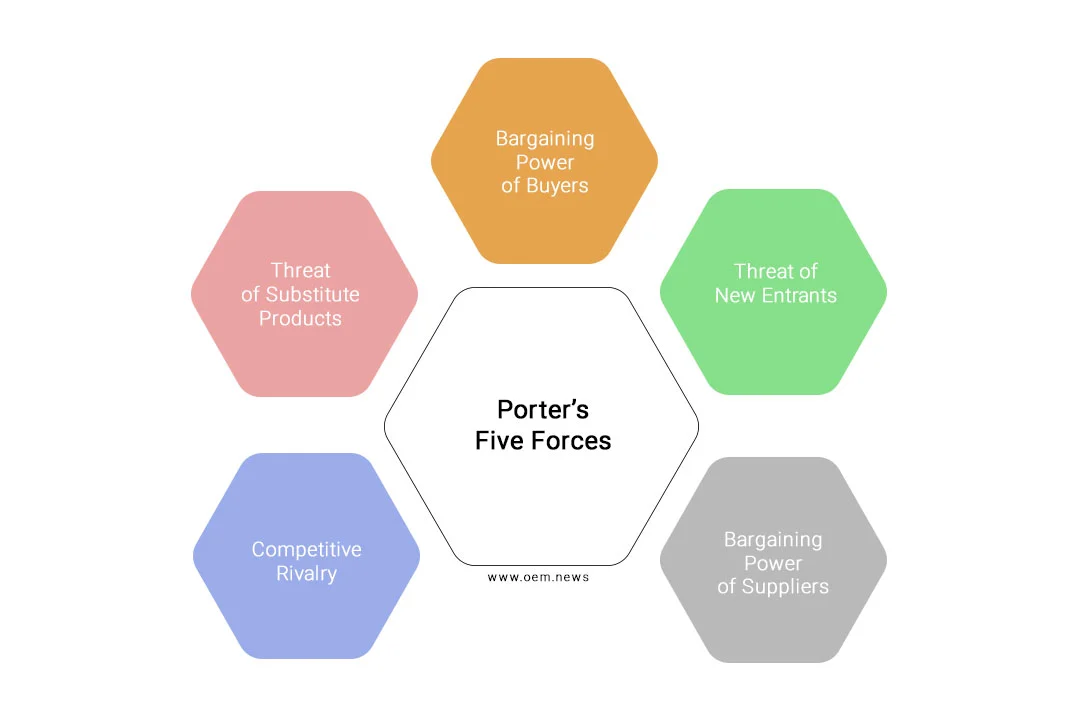But merely having competitors doesn’t make a thing awful. By finding your unique advantages over your competitors, you may utilize them to win loyal customers. That is what Porter’s Five Forces model facilitates. This article will explore Porter’s Five Forces with the Use of the model today.
What is Porter’s Five Forces model?
A model that allows you to assess the level of competition in a specific market or sector is Porter’s Five Forces. Consider it a basic business compass that enables you to ascertain the current state of your product. The framework extends beyond your interactions with your rivals.
It also considers your suppliers, end users, and nearby products that can endanger your sector. It is a thorough industry analysis that concentrates on the environment in which your product or service is being offered.
Michael E. Porter, a professor at Harvard Business School, created the instrument in 1979. He created it to assist businesses in evaluating the potential and competitiveness of various items. It soon gained popularity as a highly regarded business strategy framework for analyzing competitors after its 1979 debut.
Porter’s 5 Forces Explained
Porter’s 5 Forces is a model of analysis that aids marketers and business managers in examining the “balance of power” among various businesses in a market worldwide as well as the allure and prospective profitability of an industry sector.

1. Competitive Rivalry
The level of competition your organization confronts is the first factor to consider. Consider your industry’s total number of direct competitors and their comparative product/service offerings on a macro and micro level.
Markets with few rivals are desirable but may only last for a while. On the other hand, highly competitive marketplaces where numerous businesses are vying for the same customers weaken your power and may force you to drop your pricing and develop new items.
2. The threat of Substitute Products
The threat of substitution is another. One of the most ignored elements in any competitive analysis is this one. With cutting-edge technologies, improved infrastructure, and rising wealth in Western nations, the modern era has experienced numerous fundamental upheavals.
Thus, while innovations are essential in today’s society, they risk wiping out entire economic sectors. Accurately determining the risk these advances bring to their business model is a challenge many managers encounter. This is especially true for sectors that are not accustomed to predictable innovation cycles.
3. Bargaining Power of Buyers
Buyers are your customers. Strong buyer power can drive down prices, put rivals against one another, and demand superior quality or service at the expense of industry profitability.
When there are few buyers and numerous sellers to select from, buyers have power. In addition, if a small number of purchasers account for a significant part of a seller’s revenue, those customers will have more clout. When calculating the bargaining power of the purchasers, switching costs should also be considered.
4. The threat of New Entrants
When beginning a new firm, new entrants encounter numerous obstacles. These include creating a distribution network, having a lot of money, needing a lot of infrastructure, having patents, etc. Limited competition exists in industries with significant entry barriers. In contrast, those with low entry barriers have many participants and, as a result, a low-profit margin.
5. Bargaining Power of Suppliers
Suppliers provide your industry with the inputs it needs (e.g., components, materials, and services). There is a reasonable probability that your suppliers could increase prices or lower quality without reprisal if their bargaining strength is significant. If you have many options for suppliers, their bargaining power is probably weak. Thus, moving suppliers won’t be an issue if you need to.
How can you use these Porter’s Five Forces to improve your company?
While everyone desires a strong position in the market, several tactics are employed to achieve this. Examining your company in light of Porter’s Five Forces and comparing it to the market’s competitors is a beautiful approach to gaining and keeping market share.
After you have answers to all of the questions regarding Porter’s Five Forces, you can take wise action to improve your market position. Here are a few suggestions for actions you can take to improve your market position.
Make Your Goods Stand Out In The Marketplace
The way a product is marketed significantly impacts how well it sells. You must position your product as an exceptional offering in the market in terms of its cost, value, and capabilities. You will experience higher sales using this effective marketing strategy.
Focus More On Your Buyers
We are the dominant vendor in the market, so you must pay attention to your clients. To do this, you must concentrate on their needs and offer more affordable costs than your rivals in the market. More clients will buy from you if you offer higher quality at the best pricing.
Cost Controlling
The cost should be the last thing on your mind. You must always strive to maintain quality while attempting to offer the most excellent pricing on the market. You will lose clients if you do this.

Benefits of Porter’s 5 Forces Model
- Organizations can discover how the five factors are balanced in terms of profit.
- Organizations can use it to determine who is in charge and establish rules.
- It gives business strategists knowledge and a starting point to assess the company’s assets and liabilities.
- It gives a comprehensive picture of any industry and aids strategists in determining the key elements that can influence their position.
- It enables strategists to think more deeply about the sector and find less obvious prospects that may draw more significant investments and impact the company’s future development.
Conclusion
This crucial strategic tool was introduced to the globe by Michael Porter decades ago and is still helpful today. All five forces must be prioritized equally for a firm to expand and survive. One cannot fully control any one of these factors, let alone all of them. However, applying this paradigm to a company and keeping an eye on all these variables can help business leaders prepare for a bad day. Additionally, one can adjust their business plan using this framework to get the results they want. A company might, for instance, change to a less expensive supplier or buy a business that might turn into a rival.
Read More:
- How To Conduct a Market Analysis For Your Business
- What is PEST & PESTLE analysis? Definitions, Examples & Free Templates;
- How to conduct PEST or PESTLE Analysis: Advantages & Limitations;
- SWOT Analysis Explained: Applications, Benefits, Example & Templates
- The Franchise Business Model Explained: To Expand Globally
- International Trade disputes – Nature, Types and Resolution


